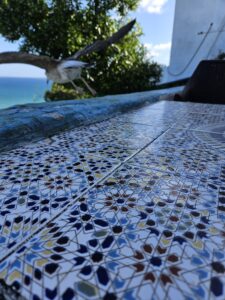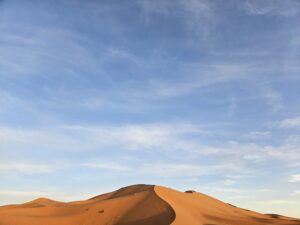Morocco (2): Deserts, Seas, and Mountains
May 2, 2024
by Scott JIAXIN
Almost every weekend in Morocco, I travelled. They were either APA organised visits or trips that were self-initiated.
The first excursion was to Fez, the “Athens of North Africa.” The cultural (and geographical) heart of Morocco, Fez was constructed by the first Moroccan king in 7th century A.D, a saudi noble who has fled from the Arabian peninsula to seek refuge in the great plains north of the Atlas Mountains. To someone who has always in his head the idea of a desert Morocco, where the landscape is dry, yellow, and inhospitable, the landscape on the road to Fez proved the contrary: beautiful rolling landscapes and hills dotted with temperate vegetation.
When we arrived, we immediately took a tour in the Medina, the ancient walled city that was Fez before modernization. It is truly one of a kind, the largest and most labyrinthic medina in the world. The steep inclines were complemented by the tight, claustrophobic alleyways that led surreptitiously to enormous Riads. In the arabic world, wealth is never shown, but hidden; such was the logic of the tiny alleyways which demonstrated a cultural conception of the public and private spheres. We toured all the artisanal activities that were present: metalworking, bakery, leather working, pottery… We didn’t stop buying souvenirs for the family, and it soon became evident that despite the rather awkward first impressions in a city flooded by tourists where locals can become too insistent and aggressive, the beauty of this ancient fortress could not be easily sullied.
Speaking of ancient monuments, nothing could beat the ruins of volubilis. A once flourishing roman city that was the most important in North Africa, there was nothing left but splintered rocks and crumbling roman columns. Still, we could see the splendour of Ancient Rome, and it was a constant reminder that Morocco, despite its strong islamic identity, was once the same as Greece, or France, 2000 years ago. The sprawling metropolis had a heating system through cleverly engineered aqueducts for the winter, as well as beautiful mosaics that still retain their tint after millenia. Unlike the colosseum or other roman vestiges, the relative pristine state of Volubilis, coupled with the savagery of wild herbs and rolling peaks in the distance, create a much more authentic feel.
Tangier, the second proper city that we visited, was special for me. Because of a visa issue, I had to leave for Spain on the day of the excursion, and I returned the following day to Tanger to take a TGV back to Rabat. Basically, I cut short our official visit, but made it up with the waiting time that I had the following day before I took the train back. It was a mediterranean city in all aspects: the slow pace of life, the strong winds, the beautiful beaches, the greenery. But at the same time, it was an international city: spanish colosseums, french street signs, italian themed buildings. I remembered sitting down in a café overseeing the entire Atlantic coastline, drinking Moroccan tea, as a seagull swooped down and perched on the ledge. A slight breeze ruffled my djellaba that I had bought in Fez, and I could see tiny specks moving on the sandy stretch which gradually dissolved into an endless blue on the horizon. That memory is etched in my head.

Next stop, the desert. As we crossed into the Middle Atlas, we saw trees, snow, and wind. It was the highlands of Morocco, and the sudden drop in temperature reminded us of the great variety that exists in this country that shares roughly the same size as spain. But once we crossed into the High Atlas, we saw the first hints of the desert. Dry, rocky mountains that eventually mould into the brownish landscape. Then, the heat comes. As we stopped in Errachidia, the prefect of the draa-tafilalet region, we took off our jackets. By the time we arrived in Rissani, an ancient carrefour for caravans, 100 kilometres from the sand dunes that we wanted to visit for so long, we were already begging for more air conditioning. And then we saw sand. Not rocky, coarse sand of the like that you see in construction sites, but fine, golden sand that seeps through your palms and leaves nothing behind. And then, dunes. Seeing them from afar is really a sight to behold. As the desert nomads call them “waves.” Huge waves that move in function of the wind, hence the moniker “shifting dunes.” The complete silence when we were riding the camels as the sun set in the distance. The milky way that appears in the night sky. The cold, dry air that leaves your throat parched after some time. The entire ambiance is so different from everything that I have experienced. A collection of these small elements, trivial when taken individually, reinforce the simply plain but absurd fact: I am in the desert.

Morocco is more than just Marrakech or Casablanca. It is deserts, forests, mountains, sea, and waterfalls (that I missed.) Maybe the next time, inshallah, when I return to this country there will be more secrets for me to uncover.





